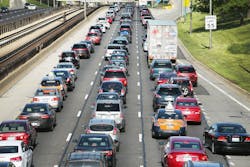GHG Phase II: Upfront costs versus payback for fleets
There has been a lot of talk about what’s to come with the second phase of the proposed Greenhouse Gas Emissions (GHG) standards.
Higher upfront costs and return on investment are two of the major concerns circulating throughout the trucking industry over GHG Phase II. Matthew Spears, center director of heavy-duty diesel standards for the Environmental Protection Agency (EPA), and Michael Roeth, executive director for the North American Council for Freight Efficiency, addressed some of those concerns and discussed what the new regulations will mean for fleets during Fleet Owner’s most recent webinar, Greenhouse Gas Emissions and Your Fleet.
According to EPA, the Phase II standards will be phased in from model years 2018 through 2027. Standards would begin in 2018 for trailers and in 2021 for all other categories. They will then increase incrementally in 2024 before being fully phased in by 2027.
When it comes to vehicle costs, fleets can expect upfront increases of around $11,700 for tractors, $1,200 for trailers, $3,400 for vocational vehicles, and $1,300 for pickups/vans. Spears explained that the cost increases would happen gradually, mainly during the implementation of the 2021 and 2024 standards.
EPA projects the overall upfront cost to the industry would be around $25 billion. However, Spears noted that tractors and trailers would generally pay for themselves within the second year of Phase II. EPA estimates that operators would save about $170 billion in fuel over the lifetime of the vehicles sold under the program.
Roeth, quoting an ATRI study on the cost of ownership of a tractor trailer in the U.S., said fuel expenses cost fleets more than drivers in 2013. He explained that the average fleet spent around $75,000 per year, per truck in fuel. He also referenced an annual fleet fuel study illustrating how 14 fleets that adopted new fuel economy technologies saved around $9,000 per year, per truck.
Roeth noted that fleets are facing some barriers and do have concerns about adopting fuel efficiency technologies. Their main concern, he said, is payback, which fleets expect to receive within the first half of ownership – typically within 18 months to two years. Roeth said other barriers/concerns include:
-
Reliability of the new technologies
-
Access to capital – when a new truck or trailer cost more than its predecessor
-
Availability of technology – As technologies come into market and begin to scale, they are only available at one or two of truck builders, Roeth explained. But when the technologies come to all truck builders, issues occur with the design, which could affect other features of the vehicle fleets may have been interested in.
-
Driver attraction and retention
-
Minimize support needs – servicing and training in the dealership
-
Changes to duty cycle
Phase II builds on Phase I standards, which began in 2014. However, this time around, the regulations will include fuel efficiency standards for trailers. Even though heavy-duty trucks and buses are responsible for only about 20% of the energy use and GHG emissions from all transportation sources, currently, combination tractors and trailers pulled by those tractors make up 65% of heavy-duty fuel consumption and GHG emissions, according to EPA. And that number is expected to grow.
“Heavy-duty happens to be the fastest growing both nationally and internationally,” Spears said.
The environmental savings over the lifetime of vehicles sold during the Phase II regulatory timeframe could total 1 billion metric tons of CO2 and 1.8 billion barrels of oil. Target reductions, according to EPA, are up to a 24% reduction of CO2 emissions and fuel consumption in 2027 for combination tractors, up to an 8% reduction for trailers pulled by combination tractors, up to a 16% reduction for vocational vehicles, up to 16% for pickups/vans, and up to 4% for engines.
The first-ever standards for heavy-duty vehicles will be fully phased in by 2018, according to EPA. Manufacturers are complying with “off-the shelf” technologies, which Spears explained are cost-effective technologies that will pay back the user in the end.
Spears said the rulemaking timeframe for Phase II would most likely occur in 2021, 2024 and 2027.
Testing to support the Phase II proposal will include hundreds of coastdown, CFD and wind tunnel aerodynamic tests; three years of engine and powertrain testing at EPA, Southwest Research Institute and Oakridge National Lab; tire rolling resistance tests of hundreds of tires; and more than 500 heavy-duty truck chassis tests.
“Proposed standards are performance based so manufacturers could choose from a wide range of technologies that work for their customers,” Spears said. “They don’t have to use the same technologies.”
“We need to provide enough time to ensure these technologies are not only developed but fully tested within the time period,” he added.
He mentioned that Phase II also includes compliance flexibilities to manufacturers for averaging, banking and trading, as well as a one-year delay for small business to help them ease into the new program.
“Higher cost is the biggest worry,” Roeth said. “If these technologies do deliver a payback in two years of time, fleets will love them. If not, they won’t buy them.”
What fleets do appreciate, according to Roeth, is that there is a long regulatory timeframe for planning and testing these new technologies.
Moving forward, the EPA’s Phase II comment period is open through Oct. 1, 2015, and the agency encourages folks to submit their comments by then. Also, the EPA will hold its heavy-duty technology showcase on Oct. 13. According to Spears, the EPA’s and National Highway traffic Safety Administration’s goal is to issue a joint final rulemaking on Phase II around the second quarter of 2016.
About the Author

Cristina Commendatore
Cristina Commendatore is a past FleetOwner editor-in-chief. She wrote for the publication from 2015 to 2023.
